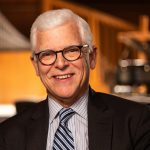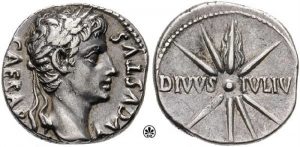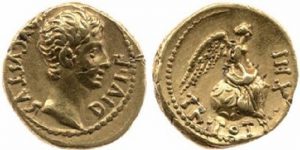
“The beginning of the good news about Jesus the Messiah, the Son of God” (Mark 1:1, NIV).
“And when the centurion, who stood there in front of Jesus, saw how he died, he said, ‘Surely this man was the Son of God!’” (Mark 15:39, NIV).
Roman Imperial Power
 The Gospel of Mark begins and ends with a direct challenge to Roman imperial power. Mark wrote to persecuted Christians in the heart of the empire – the City of Rome – and makes the claim that Jesus the crucified Messiah is the Sovereign, not the emperor. Questions about the powers still swirl around us.
The Gospel of Mark begins and ends with a direct challenge to Roman imperial power. Mark wrote to persecuted Christians in the heart of the empire – the City of Rome – and makes the claim that Jesus the crucified Messiah is the Sovereign, not the emperor. Questions about the powers still swirl around us.
The Roman ruler Julius Caesar met an untimely end when the assassins Brutus, Decimus, Cassius, and others stabbed him twenty-three times during a meeting of the Roman Senate on the Ides of March (the 15th) in 44 BC. Two years later, the Senate declared that Julius was divine, a god.
Four months after Julius’ death, a bright comet appeared. The Roman historian Suetonius said, “a comet shone for seven successive days, rising about the eleventh hour, and was believed to be the soul of Caesar, who had been taken to heaven.” The comet and the “deification” of Julius are commemorated in coins that bear the inscription “Divine Julius.”
Octavian, who later became the emperor Augustus, had been adopted by his great uncle Julius Caesar and, as the son of the divinized Julius, was called divi filius – “the son of god.” The title appears in numerous coins and inscriptions during his day, often abbreviated DIVI F.
 Cities erected temples and even established priesthoods to honor Julius Caesar and Augustus. One inscription from the city of Thessalonica commemorates a proconsul who “built the temple of Caesar, in the time of the priest and agonothete of Imperator Caesar Augustus, son of god.”
Cities erected temples and even established priesthoods to honor Julius Caesar and Augustus. One inscription from the city of Thessalonica commemorates a proconsul who “built the temple of Caesar, in the time of the priest and agonothete of Imperator Caesar Augustus, son of god.”
The Gospel of Christ and Roman Power
The Gospel of Mark begins and ends with the astounding and challenging claim: not the emperor but Jesus the Messiah is the true Son of God, as God the Father declared (Mark 1:11). Even a Roman soldier, a centurion, got the point: “Truly this man was God’s Son!” (Mark 15:39, NRSV).
Mark informs the Roman Christians that the real sovereign is Jesus Christ, the one who was crucified and then raised from the dead. Mark’s Gospel stands over against the way the Roman Empire merged its claims of imperial power with the divinization of its rulers. Political power and religion were joined at the hip in common cause.
For Mark, the nature of Jesus’ rule was entirely different than that envisioned and embodied by Rome. The key verse where Jesus summarizes his ministry is Mark 10:45: “For even the Son of Man did not come to be served, but to serve, and to give his life as a ransom for many” (NIV). Jesus’ words echo Isaiah 53:11-12, which describe the Suffering Servant of God who “poured out his life unto death and … bore the sin of many.”
Jesus’ sacrificial death for our sins and his service to others contrast starkly with Roman political domination, power, and pride. Christ is the Sovereign over all, not Caesar (Matthew 28:19-20), but he does not wield a sword. Jesus’ self-sacrificing service then became the model for his disciples to follow: “You know that those who are regarded as rulers of the Gentiles lord it over them, and their high officials exercise authority over them. Not so with you. Instead, whoever wants to become great among you must be your servant, and whoever wants to be first must be slave of all” (Mark 10:42-44). This was not the Roman way.
The Church and the Powers
Through the centuries, the church of the Lord Jesus Christ has wrestled with its relationship to the political, social, and economic powers of the day. At times, a nearly complete alignment formed between the state and the church. The Emperor Constantine set that direction for centuries to come. The ancient church historian Eusebius told how Constantine was marching with his soldiers and saw a cross above the sun together with the words toutō vika, “In this, conquer.” He morphed the cross into a battle-sign against his enemies. Political and military power became strangely mixed with the symbol of the Crucified One, the Suffering Servant, Jesus.
Mark’s Gospel pulls in an entirely different direction by “speaking truth to power,” as some say. Mark does not avoid politics but understands that the Crucified Christ’s authority stands as a counterpoint to and critique of oppressive Roman power with its religious claim of divine sanction.
Which Way?
In our highly divided and polemic era, churches and believers all around struggle to understand our relationship to politics and social trends. The Gospel of Mark points the way down a road decidedly different than that of Constantine or Augustus. We challenge the powers and serve sacrificially. Jesus is Lord, not Caesar. As Sovereign he serves.
After William Wilberforce became a Christian around 1785, he dedicated himself to humanitarian reform and worked to bring about the abolition of slavery. He challenged the political and economic powers of his day and brought change.
During my years working in Costa Rica, I came to know the ministry and leaders of “Caravanas de Buena Voluntad,” a Christian organization dedicated to providing medical and dental care throughout the country, especially in rural areas where healthcare was not readily accessible. The doctors and other personnel of Caravanas sacrificially served those who were in the greatest need, people on the margins of society.
Which way will we go in the next years? Society is asking, the church is asking, and the Lord is asking. Mark hands us the roadmap for the “Way of the Lord.”
 Dr. Gene L. Green is the Dean of Trinity International University – Florida. Visit them at tiu.edu/florida
Dr. Gene L. Green is the Dean of Trinity International University – Florida. Visit them at tiu.edu/florida
Read last month’s article by Dr. Gene L. Green at: goodnewsfl.org/violence-in-the-land/

Comments